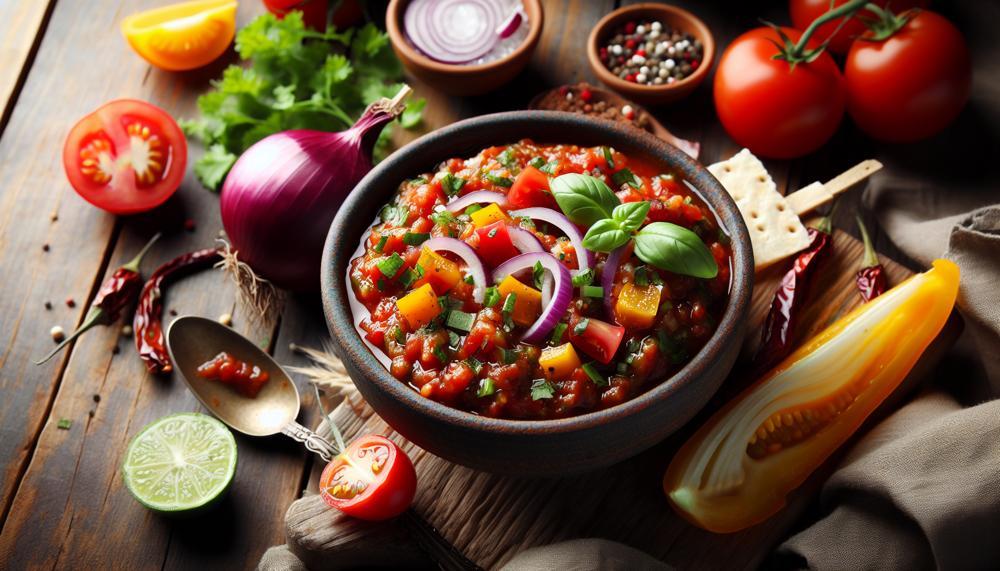Yes, homemade salsa can go bad, but it usually lasts 3–7 days in the fridge if covered properly. The quality of the ingredients and utensils used, as well as good hygiene, are important factors in determining the salsa’s shelf life.
Due to the absence of preservatives in homemade salsa, its shelf life is relatively shorter. It’s essential to understand how long homemade salsa lasts and how to determine if it has gone bad to ensure your salsa is fresh and safe to consume. Let’s delve into the details.
Contents
Key Takeaways:
- Homemade salsa has a shorter shelf life compared to store-bought salsa due to the lack of preservatives.
- Proper storage and refrigeration are crucial to prevent spoilage.
- Homemade salsa typically lasts for 3-7 days when refrigerated.
- Store-bought salsa with preservatives can last up to 2 weeks in the refrigerator after opening.
- Expired salsa should be discarded to avoid potential foodborne illness.
How Long Does Homemade Salsa Last?

Homemade salsa can last for about 3-7 days if properly covered and refrigerated. Since there are no preservatives added, the freshness of the salsa diminishes relatively quickly. It is essential to consume homemade salsa within the recommended time frame to ensure its quality and safety.
How Long Does Store-Bought Salsa Last?
When it comes to store-bought salsa, the inclusion of preservatives extends its shelf life compared to homemade options. Store-bought salsa with added preservatives can last up to 2 weeks in the refrigerator after opening. These preservatives, such as sugar, vinegar, and salt, help maintain the salsa’s freshness and taste for a longer period.
However, it is important to note that proper storage and refrigeration are still necessary to ensure the salsa’s longevity. Be sure to seal the jar tightly after each use and store it in the refrigerator at the appropriate temperature.
Shelf Life of Salsas
| Salsa Type | Shelf Life |
|---|---|
| Homemade salsa | 3-7 days in the fridge |
| Store-bought salsa (opened) | Up to 2 weeks in the fridge |
| Store-bought salsa (unopened) | Up to a year without refrigeration |
How to Tell if Your Salsa Has Gone Bad
When it comes to salsa, freshness is key. It’s important to know how to tell if your salsa has gone bad to avoid any potential health risks. Here are some signs to look out for:
- Change in color or texture: If your salsa has turned a strange color or has become watery, it may be a sign of spoilage.
- Mold growth on the surface: Visible mold growth is a clear indication that your salsa has gone bad and should be discarded.
- Foul odor upon opening: A unpleasant or off smell when you open the jar is a strong indicator that your salsa has spoiled.
- Dents or swelling on the lid of the jar: Any abnormality in the jar’s lid, such as dents or swelling, could be a sign that the salsa has gone bad.
- Lack of a “pop” when opening the lid for the first time: If the lid doesn’t make a popping sound when you open it for the first time, it may indicate that the salsa has lost its freshness.
- Separation of ingredients: If you see a noticeable separation of the ingredients in your salsa, it could be a sign of spoilage.
- A bad taste: Perhaps the most obvious sign that your salsa has gone bad is a noticeably off or unpleasant taste.
If you observe any of these signs, it is best to err on the side of caution and discard the salsa. Consuming spoiled salsa can lead to foodborne illnesses, so it’s better to be safe than sorry.
| Signs of Spoiled Salsa | Action to Take |
|---|---|
| Change in color or texture | Discard salsa |
| Mold growth on the surface | Discard salsa |
| Foul odor upon opening | Discard salsa |
| Dents or swelling on the lid of the jar | Discard salsa |
| Lack of a “pop” when opening the lid for the first time | Discard salsa |
| Separation of ingredients | Discard salsa |
| A bad taste | Discard salsa |
Tips for Extending Salsa Shelf Life
Here are some tips to help you extend the shelf life of your salsa:
- Refrigerate homemade salsa immediately after preparation to slow down bacterial growth and maintain its freshness.
- Use clean utensils when dipping or scooping salsa from the jar to avoid introducing contaminants that could lead to spoilage.
- Seal the jar tightly after each use to prevent air from entering and causing the salsa to spoil.
- Store unopened salsa in a cool, dry place away from direct sunlight to preserve its flavor and quality.
- If you have a surplus of salsa or if it’s close to its expiration date and won’t be consumed in time, consider freezing it. Freezing salsa can help extend its shelf life by several months.
By following these tips, you can enjoy your salsa for longer periods and minimize food waste.
Is it Safe to Eat Expired Salsa?
When it comes to expired salsa, it’s best not to take any chances. Eating salsa that has passed its expiration date can pose a risk of foodborne illness. The quality and safety of salsa can deteriorate over time, especially if it has not been stored properly.
Expired salsa may develop mold growth, change in color or texture, emit a foul odor, or taste unpleasant. These are clear signs that the salsa is no longer safe to consume.
Food safety guidelines recommend discarding expired salsa to avoid potential health risks. It’s important to prioritize your well-being and adhere to proper food handling practices.
When storing salsa, make sure to check the expiration date and follow the recommended storage instructions. Properly sealed and refrigerated salsa has a longer shelf life and is less likely to spoil.
In summary, it is not safe to eat expired salsa. To ensure your health and enjoyment of salsa, it’s best to consume it within the recommended timeframe and properly store any leftovers.
Can You Freeze Salsa?
Yes, you can freeze salsa. Freezing salsa is a great option if you have a surplus or if the salsa is nearing its expiration date. Be aware that the texture and taste may change slightly upon thawing.
When freezing salsa, it’s important to use proper storage techniques to maintain its quality. Here are some steps to follow:
- Cool the salsa: Allow the salsa to cool completely before storing it in the freezer. This helps prevent condensation and ice crystals from forming.
- Use freezer-safe containers: Transfer the salsa to airtight freezer-safe containers or freezer bags. Make sure to leave some room for expansion as the salsa freezes.
- Label and date: Clearly label the containers or bags with the contents and the date of freezing. This will help you keep track of the salsa and ensure you consume it within a reasonable timeframe.
- Freeze promptly: Place the sealed containers or bags in the freezer and freeze them as quickly as possible. The faster the salsa freezes, the better the quality will be when thawed.
To thaw frozen salsa, transfer it to the refrigerator and allow it to thaw slowly overnight. Avoid thawing it at room temperature, as this can promote bacterial growth.
Note: While frozen salsa can be safely consumed for up to 3 months, it’s best to consume it within the first month for optimal flavor and texture.
| Salsa Type | Shelf Life in Freezer | Best Before Thawing |
|---|---|---|
| Homemade Salsa | Up to 3 months | Within 1 month |
| Store-Bought Salsa | Up to 3 months | Within 1 month |
Can You Eat Salsa That’s Been Left Out Overnight?
It is not recommended to consume salsa that has been left out overnight. Bacteria can grow rapidly at room temperature, making the salsa unsafe to eat. It is best to refrigerate salsa promptly after use to prevent bacterial growth and maintain its freshness.
Conclusion
After considering the shelf life of homemade and store-bought salsa, it is clear that proper storage and refrigeration are essential to maintain the freshness and safety of this popular condiment. Homemade salsa can go bad within a few days, while store-bought salsa with preservatives can last up to 2 weeks.
When it comes to homemade salsa, it is important to consume it within 3-7 days of preparation. Since homemade salsa lacks preservatives, its freshness diminishes quickly. Refrigeration is crucial to slow down the spoilage process and ensure the salsa remains safe to eat.
On the other hand, store-bought salsa with added preservatives can last longer, up to 2 weeks, in the refrigerator after opening. The preservatives, such as sugar, vinegar, and salt, extend the shelf life of the salsa. However, proper storage and refrigeration are still necessary to maintain its freshness and taste.
When determining if salsa has gone bad, there are several signs to look out for, including a change in color or texture, mold growth, foul odor, dents or swelling on the jar lid, lack of a “pop” when opening the jar, separation of ingredients, and a bad taste. If any of these signs are present, it is best to discard the salsa to avoid potential foodborne illness.
To extend the shelf life of salsa, it is recommended to refrigerate homemade salsa immediately after preparation, use clean utensils when scooping from the jar, seal the jar tightly after each use, store unopened salsa in a cool, dry place, and freeze salsa if there is a surplus or if it’s nearing its expiration date.
So, proper storage, refrigeration, and timely consumption are crucial to prevent spoilage and ensure the safety of salsa. Always check for signs of spoilage before consuming salsa, and remember to follow food safety guidelines to protect yourself and your loved ones.
Source Links
- https://www.mikeyvsfoods.com/post/how-long-does-salsa-last
- https://pepperpalace.com/blogs/expert-tips/when-salsa-goes-bad-tips-for-keeping-salsa-fresh
- https://pepperscale.com/does-salsa-go-bad/




